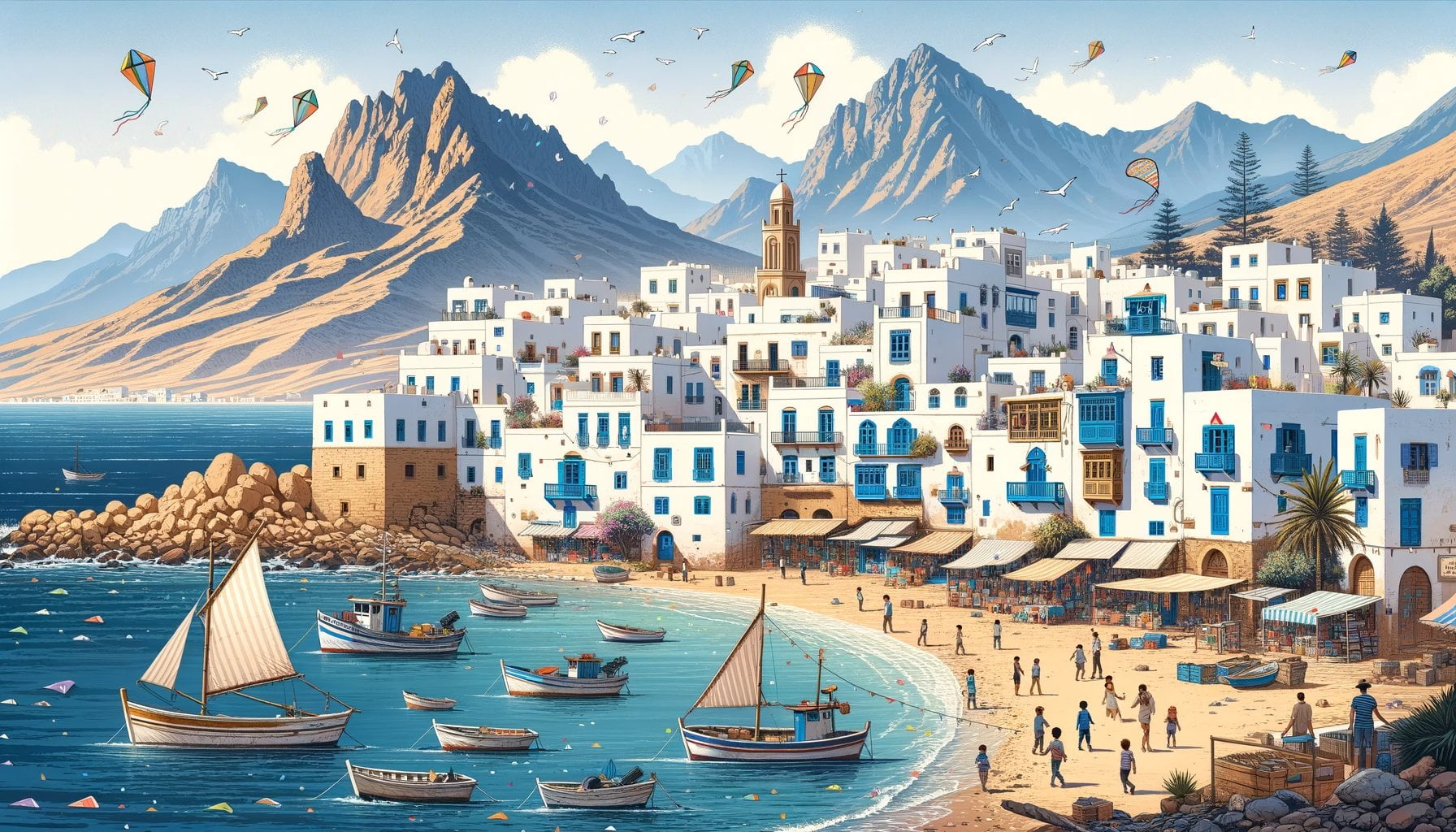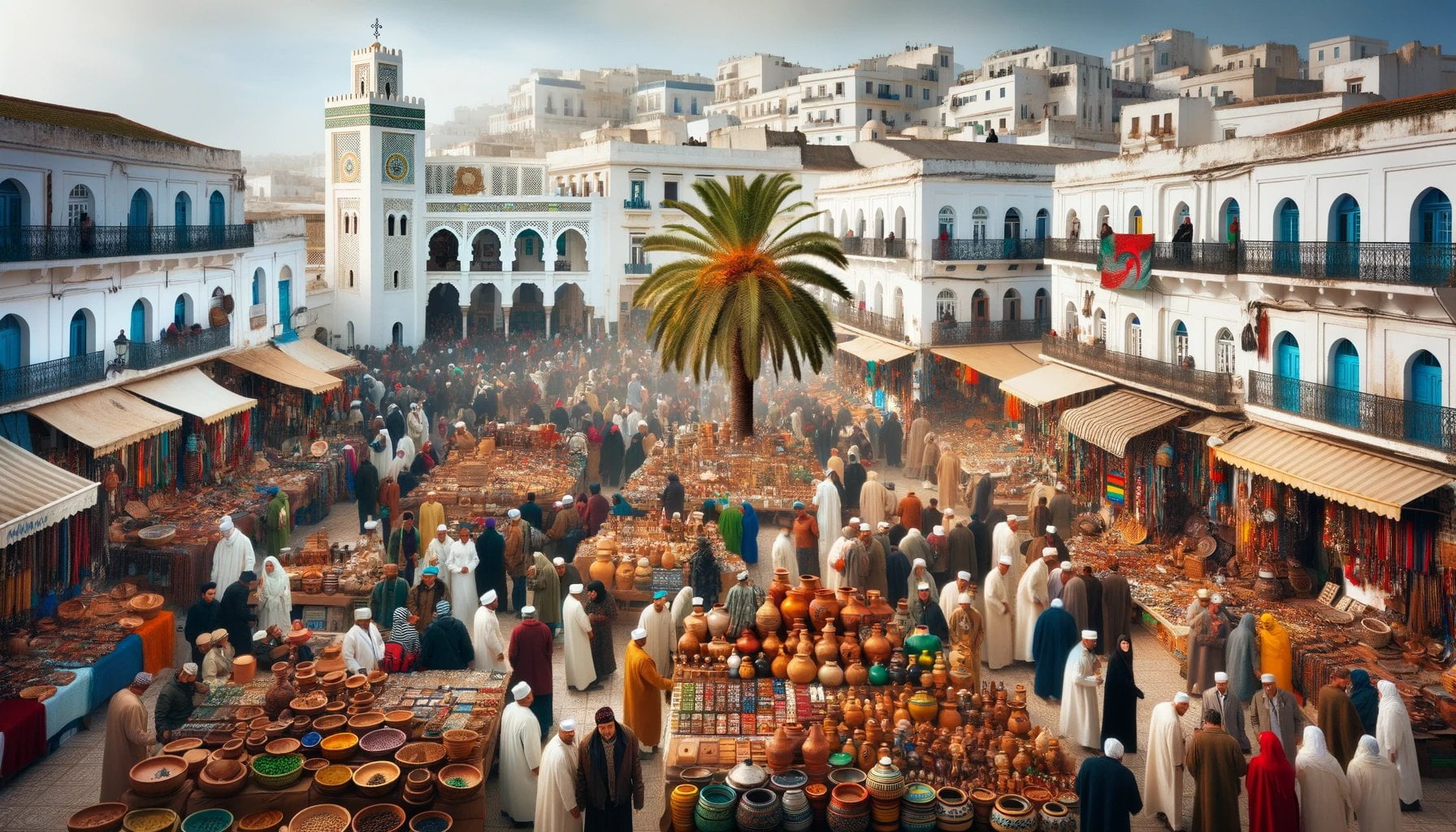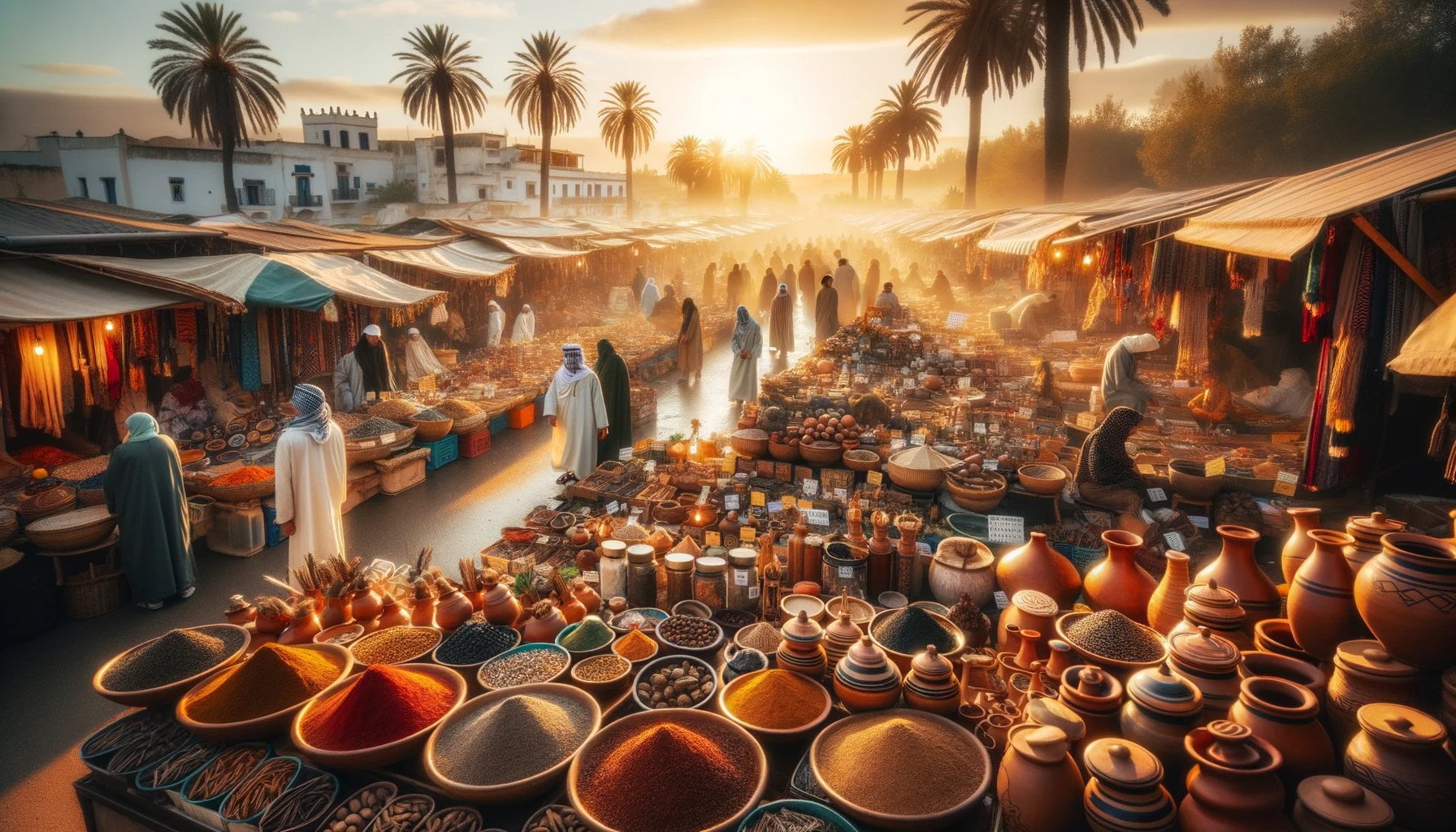Algeria’s Cultural Heritage: Unearthing Treasures of Tradition offers a captivating glimpse into the rich tapestry of Algerian culture. From its vibrant traditions to its exquisite art, tantalizing cuisine, and fascinating history, this article delves deep into the heart of Algeria’s cultural wonders. With a seasoned writer’s keen eye for detail and a passion for unearthing hidden gems, get ready to embark on a journey through the enchanting world of Algerian heritage.

Key Takeaways:
- Algeria’s cultural heritage is rich and diverse, influenced by various ethnic groups such as Berber and Arab cultures.
- The country’s history encompasses different periods, including the Phoenician, Muslim and Ottoman eras, as well as French colonization.
- Algerian culture is renowned for its intricate carpet weaving, delicate pottery work, wooden sculptures, copperwares, ceramic art, basket making, and jewelry design.
- Literature holds a significant place in Algerian culture, with French being the second most spoken language in the country after Arabic.
Algeria Culture
Algeria is a country with a rich and diverse cultural heritage, shaped by centuries of history and influenced by various ethnic groups. From the Phoenician era to the Muslim and Ottoman periods, as well as French colonization, Algeria’s culture is a tapestry of traditions, customs, art, music, food, clothing, and historical influences. Let’s delve into the treasures of Algeria’s cultural heritage and explore what makes it truly unique.
A Melting Pot of Ethnicities
Algeria’s cultural landscape is a vibrant mix of influences from different ethnic groups, with Berber and Arab cultures playing a significant role. The Amazigh or Berber people have a strong presence in Algeria, and their traditions and customs have left an indelible mark on the country’s identity. These ancient practices, deeply rooted in North African heritage, are celebrated through colorful festivals, music, and intricately designed arts and crafts.
The Art of Expression
Artistic expression is at the heart of Algerian culture. From intricate carpet weaving to delicate pottery work, the artistic skills of Algerians have been honed over generations. Wooden sculptures, copperwares, ceramic art, basket making, and jewelry design showcase the exceptional craftsmanship and attention to detail found in Algerian art. These forms of art not only showcase the talent of local artisans but also reflect the diverse influences that have shaped Algeria’s cultural heritage.
Literary Gems
Literature also holds a special place in Algerian culture. Algerian writers have made significant contributions to the world of literature, with their works reflecting the social, political, and cultural realities of their time. French, the second most spoken language in Algeria after Arabic, has been a significant medium for literary expression. Algerian authors use their words to explore the complexities of identity, history, and societal issues, providing unique perspectives on Algerian culture and its people.
A Gastronomic Delight
No exploration of culture is complete without indulging in the local cuisine, and Algeria certainly doesn’t disappoint. Algerian food showcases a blend of flavors and influences from Mediterranean, Arabic, and Berber cuisines. Staple dishes include couscous, tagines, merguez sausages, and various vegetable-based stews. Algerians also have a passion for sweet treats such as baklava and makroud. Exploring the diverse flavors of Algerian cuisine is a delightful way to immerse oneself in the country’s cultural heritage.
Cultural Diversity and Unity
Algeria’s cultural heritage is a testament to the country’s diversity and the unity that transcends ethnic differences. Despite the challenges faced over the years, the people of Algeria have managed to preserve and celebrate their cultural traditions. This unity is often showcased in the myriad of music and dance forms that exist in Algeria. From the rhythmic beats of traditional Algerian music to the energetic performances of traditional dances, these art forms serve as a bridge connecting generations and preserving the essence of Algerian culture.
Note: The information shared in this article draws insights from multiple sources, including the Consulate General of Algeria and Planet JAWAL, to provide a comprehensive understanding of Algeria’s cultural heritage.
If you’re curious about the fascinating facts about Algeria, don’t miss out on exploring our page on facts about Algeria! Discover intriguing information about this beautiful country.
Are you dreaming of a vacation filled with adventure and cultural experiences? Dive into the world of tourism in Algeria to unveil breathtaking landscapes and charming cities that will leave you in awe.
Discover the rich and captivating history of Algeria by delving into our page on Algeria history. Unearth the secrets of this ancient land and understand the events that have shaped its identity.
Embark on a virtual journey to explore the most famous places in Algeria. From the stunning Sahara Desert to the historic Casbah, our page on famous places in Algeria will transport you to these remarkable destinations.
Indulge in the flavorful delights of Algerian cuisine by clicking on our page on Algeria cuisine. From savory couscous to aromatic tagines, immerse yourself in the culinary wonders this country has to offer.
Algerian Art and Architecture
Algeria’s rich cultural heritage is deeply rooted in its art and architecture. Throughout history, various influences and cultural forces have shaped the unique architectural styles found in Algeria today. From ancient Carthage to the Roman era and the early Islamic period, each era has left its mark on the country’s built environment.
Historical Influences
Ancient Carthage
Ancient Carthage, which gained control of coastal Algeria by the 4th century BC, played a significant role in shaping Algerian architecture. The integration of Punic, Hellenistic, and Roman styles into existing architectural traditions resulted in a diverse range of structures. One can witness the fascinating blend of these influences in the design and aesthetics of ancient Algerian buildings. [Source]
Royal Numidian architecture
Under the ancient Berber kingdoms of Numidia and Mauretania, Algeria witnessed urban development and the construction of notable monuments. Known as “Numidian Royal Architecture,” these structures, including tombs, tumuli, and sanctuaries, combined various architectural styles while often referencing Hellenistic and Punic motifs. The Medracen tomb and the Royal Mausoleum of Mauretania are prominent examples of this architectural fusion. [Source]
Roman era
The Romans annexed eastern Numidia in 46 BC, incorporating it with Western Numidia and Tripolitania to form the Roman province of Africa Proconsularis. This period marked a significant architectural transformation in Algeria. Over 500 towns and cities were built, characterized by Roman urban planning with orthogonal grid layouts and forums. Timgad, established by Trajan, offers a well-preserved example of Roman urban planning in Algeria. [Source]
Early Islamic era
With the arrival of Islam in the 7th century, Algerian architecture experienced another wave of influences. Muslim cities in Algeria embraced unique architectural features such as the souq (commercial center), hammam (social center), and mosque with an accompanying madrasah (religious center). The old district of Algiers, the Casbah, emerged during this era. The architectural legacy of the early Islamic period is evident in the intricate details and designs found in Algerian buildings. [Source]
Key Takeaways:
- Ancient Carthage’s influence is seen in Algeria’s diverse architectural styles.
- The Royal Numidian architecture showcases a fusion of various influences and motifs.
- Roman urban planning left a remarkable mark on Algeria’s built environment.
- The early Islamic era introduced distinctive features to Algerian architecture.
The Vibrant Music and Dance Scene in Algeria
Algeria, a country with a rich cultural heritage, is home to a vibrant and diverse music and dance scene that showcases the country’s identity and traditions. Influenced by Arab, Berber, and African cultures, Algerian music is a captivating mix of traditional and contemporary styles that have evolved over centuries. From the pulsating rhythms of raï to the traditional melodies of haouzi, the music of Algeria is a treasure trove of cultural wonders.
Key Takeaways:
– Algerian music is a fusion of Arabic, Berber, and African influences, reflecting the country’s diverse cultural heritage.
– The most popular genre of Algerian music is raï, which has gained popularity not only in Algeria but also in France, Spain, and other parts of Europe.
– Traditional Algerian music is deeply rooted in styles inherited from Al-Andalus, with a unique North African twist.
– Famous Algerian musicians, including Beihdja Rahal, Brahim Hadj Kacem, Nouri Koufi, and Leila Borsali, have made significant contributions to the country’s music scene.
– Haouzi music, often played at weddings and ceremonies, is another popular style in Algeria that showcases the country’s musical diversity.
The Rhythms of Raï: a fusion of cultures
One cannot delve into the vibrant music scene of Algeria without exploring the captivating genre of raï. With its roots in the Oran region, raï music emerged as a popular form of expression among the working-class communities in the early 20th century. Its sound, characterized by lively rhythms and soulful vocals, reflects a fusion of Arab, Berber, and African musical influences.
Raï music gained international recognition in the 1980s and 1990s, primarily due to the pioneering work of artists such as Cheb Khaled and Cheb Mami. These talented musicians brought raï to the forefront of global music, blending traditional Algerian sounds with contemporary beats and melodies. Today, raï continues to evolve, embracing new trends and styles while remaining deeply rooted in its Algerian origins.
Traditional Melodies of Haouzi
While raï may be the most well-known genre of Algerian music, it is just one facet of the country’s vibrant musical landscape. Haouzi music, characterized by its intricate melodies and poignant lyrics, holds a special place in Algerian culture. This traditional style, originating from the cities of Tlemcen and Mascara, reflects the influences of Andalusian music and Arab-Andalusian poetry.
Typically played during festive occasions, such as weddings and ceremonies, haouzi captivates listeners with its soulful compositions. The melodic interplay between instruments like the oud, violin, and percussion creates an enchanting atmosphere, transporting audiences to a bygone era. Haouzi represents the deep-rooted traditions and rich history of Algeria, preserving the essence of its cultural heritage for generations to come.
The Dance of Rhythms: Expressive Movements
Algerian music is inseparable from its vibrant dance forms, which provide a visual representation of the country’s rhythmic beats and melodic tunes. Traditional Algerian dances, such as the Chaabi and Kabyle dances, embody the spirit and vitality of the Algerian people.
The Chaabi dance, originating from the streets of Algiers, is known for its energetic movements and infectious rhythms. It serves as a form of self-expression, allowing individuals to connect with their cultural roots and celebrate their identity. Similarly, Kabyle dances, hailing from the Kabylie region, showcase the grace and elegance of Algerian tradition. With their precise footwork and graceful gestures, these dances capture the essence of Algerian music and culture.
Celebrating Algeria’s Cultural Heritage
The vibrancy of Algeria’s music and dance scene is a testament to the country’s rich cultural heritage. These art forms serve as a bridge, connecting generations and preserving the traditions and customs that define Algeria. From raï to haouzi, and the expressive movements of traditional dances, Algerian music and dance transport us to a world where history, culture, and emotion intertwine.
Through the rhythms and melodies that flow through its veins, Algeria invites us to discover the treasures of its cultural heritage. So, let the vibrant music and dance scene of Algeria ignite your senses and take you on a captivating journey through its diverse and enchanting traditions.
Sources:
– Discover Algerian Heritage: Culture, Traditions, Festivals – overyourplace.com
– Algerian music | Britannica – Encyclopedia Britannica
Discovering the Flavors of Algerian Cuisine
Algerian cuisine is a true reflection of the country’s rich cultural tapestry, blending North African, Mediterranean, Arab, Berber, and French influences. The flavors and textures found in Algerian cuisine tell a captivating story of centuries of history and the diverse ethnic groups that have shaped the country’s culinary traditions. From aromatic spices to mouthwatering dishes, Algerian cuisine offers a delightful exploration of flavors that will leave you craving for more.
One of the most iconic dishes in Algerian cuisine is couscous, which also happens to be the national dish of Algeria. This flavorful grain, traditionally made from semolina, is often accompanied by a savory stew of vegetables, meat, or poultry. The combination creates a symphony of flavors that exemplify the rich heritage and cultural diversity of Algerian cuisine.
Harissa and dersa are two popular sauces used in Algerian cuisine to add depth and spice to dishes. Harissa is a fiery paste made from roasted peppers, garlic, and spices, while dersa is a blend of crushed garlic, herbs, and olive oil. These sauces infuse Algerian dishes with intense flavors and add a distinct North African touch to the cuisine.
Spices play a crucial role in Algerian cuisine, adding complexity and depth to dishes. Cumin, coriander, cinnamon, and turmeric are commonly used, creating a harmonious blend of flavors that tantalize the taste buds. Algerian cuisine embraces the use of aromatic spices, resulting in dishes that are both flavorful and fragrant.
Beyond the savory dishes, Algerian cuisine also offers a tempting array of sweet treats. Algerian pastries are renowned for their delicate textures and rich flavors. These pastries are often made with nuts, honey, and fragrant floral waters, reflecting the country’s historical influences. From the flaky and almond-filled makroudh to the syrup-drenched and sesame-coated chebakia, these pastries are a true indulgence.
To complement the vibrant flavors of Algerian cuisine, refreshing beverages are a must-try. Fruit juices and soft drinks like gazouz are common in Algeria, with one popular Algerian soda being Hamoud Boualem. These beverages provide a refreshing contrast to the bold and robust flavors of the cuisine, giving a well-rounded dining experience.
Key Takeaways:
- Algerian cuisine is a fusion of North African, Mediterranean, Arab, Berber, and French influences.
- Couscous, accompanied by flavorful stews, is the national dish of Algeria.
- Harissa and dersa are popular sauces used to enhance the flavors of Algerian dishes.
- Spices like cumin, coriander, cinnamon, and turmeric add depth and complexity to Algerian cuisine.
- Algerian pastries are known for their delicate textures and rich flavors, often featuring nuts, honey, and floral waters as key ingredients.
- Fruit juices and soft drinks, such as gazouz and Hamoud Boualem, are commonly enjoyed in Algeria.
Sources:

FAQ
Q1: What is the cultural heritage of Algeria?
A1: The cultural heritage of Algeria is rich and diverse, influenced by various ethnic groups such as Berber and Arab cultures. It includes traditions, art, cuisine, and history that have shaped the identity of the nation.
Q2: What are some key architectural influences in Algeria?
A2: Algeria’s architecture has been influenced by different historical events and cultural forces. Some important architectural influences include Ancient Carthage, Numidian Royal Architecture, Roman era urban planning, and the development of cities during the early Islamic era.
Q3: What is the significance of music in Algerian culture?
A3: Music plays a significant role in Algerian culture, showcasing a vibrant fusion of Arabic, Berber, and African influences. The most popular genre of Algerian music is raï, which has gained popularity not only in Algeria but also in France, Spain, and other parts of Europe.
Q4: How does Algerian cuisine reflect the country’s cultural tapestry?
A4: Algerian cuisine is influenced by North African, Mediterranean, Arab, Berber, and French cultures, reflecting the country’s diverse history. It incorporates flavorful spices and herbs, with dishes like couscous, tajine, and savory pastries showcasing the richness of Algerian culinary traditions.
Q5: How has Algerian culture been shaped by its history?
A5: Algerian culture and society have been influenced by a range of historical factors, including 130 years of French colonial rule. This has led to a complex blend of Arab, Berber, Turkish, Spanish, Roman, and French influences that shape various aspects of Algerian culture, including language, music, cuisine, and society.
“`json
“`












